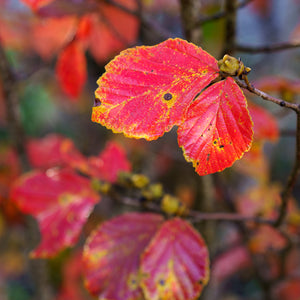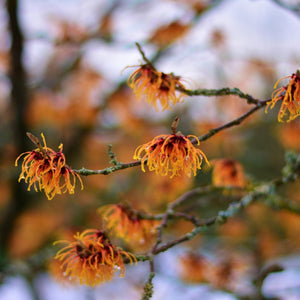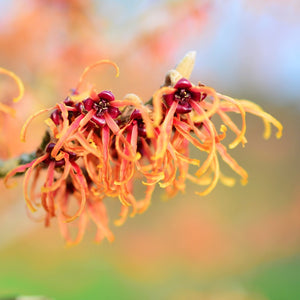The Witch Hazel Guide
Witch hazel (Hamamelis spp.) is a standout shrub in the winter landscape, known for its spidery, fragrant flowers that bloom when most plants are dormant. With varieties flowering from late fall through early spring, witch hazel adds unexpected color and interest when it’s needed most. Its elegant, vase-shaped habit and tolerance for a range of conditions make it a valuable addition to any garden design.
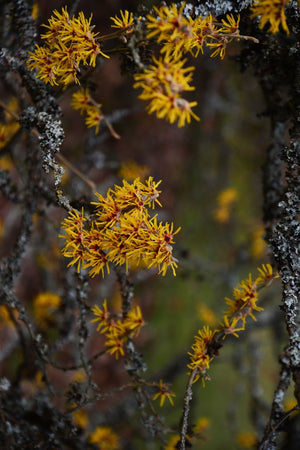
About
The Hamamelis genus includes several species and hybrids, each with distinct bloom times, flower colors, and growth habits. Native species include:
- Hamamelis virginiana (Common Witch Hazel): Blooms in late fall with yellow flowers and is native to eastern North America.
- Hamamelis vernalis (Ozark Witch Hazel): Native to the central U.S., it blooms in late winter with yellow to red-orange flowers and often has fragrant blooms.
Hybrids such as Hamamelis × intermedia—a cross between Hamamelis japonica and Hamamelis mollis—are favored for their showy, fragrant flowers and wide range of colors:
- ‘Arnold Promise’: Bright yellow blooms in late winter.
- ‘Diane’: Coppery red flowers with strong fragrance.
- ‘Jelena’: Orange ribbon-like petals with excellent fall color.
- ‘Barmstedt Gold’ and ‘Rubin’: Noted for their vivid golden and red hues, respectively.
- ‘Amethyst’: A newer variety with deep purple-toned flowers.
Witch hazel grows in a vase-shaped form, typically reaching 10 to 15 feet tall and wide, though some varieties may be more compact or expansive. The fall foliage is often brilliant yellow, orange, or red, providing multi-season appeal.
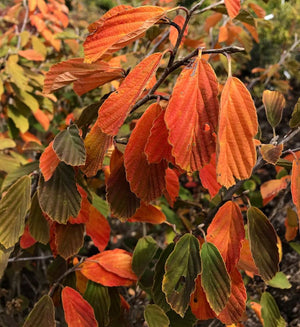
PLANTING
USDA Hardiness Zones: Most witch hazel species thrive in Zones 4–8, depending on cultivar and origin.
Soil: Prefers rich, loamy, well-drained soil but is adaptable to clay or sandy conditions if drainage is sufficient.
Sunlight: Grows well in full sun to partial shade. Full sun promotes the most vibrant flowering and best fall color.
Watering: Needs consistent moisture during establishment. Once mature, it is moderately drought tolerant but prefers evenly moist soil.
Spacing: Allow 10–15 feet between plants or from structures to accommodate mature width and air circulation.
Planting Time: Plant in early spring or fall to allow roots to establish in cool weather.
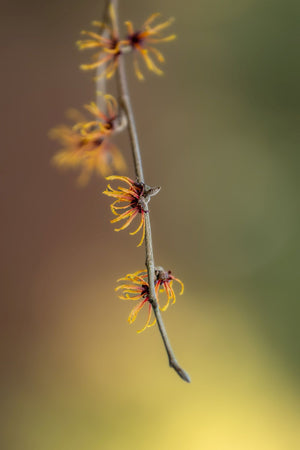
CARE
Watering: Water deeply during dry periods, especially in the first two to three years. Mulch helps conserve moisture and stabilize soil temperature.
Fertilizing: Not heavy feeders. Apply compost or a balanced fertilizer in early spring if needed, particularly in poor soils.
Pruning: Minimal pruning is required. Prune just after flowering to shape or remove crossed and damaged branches. Avoid hard pruning, which can disrupt next year’s flowering.
Pests and Diseases: Generally pest-free. Some leaf spots or powdery mildew may appear but are not typically serious with good airflow.
Mulching: Use a 2–3 inch mulch layer to retain moisture and suppress weeds. Keep mulch a few inches from the base of the trunk.
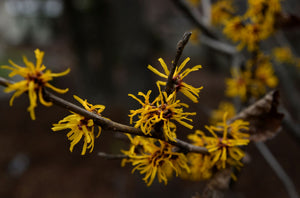
HOW TO USE
Winter Focal Point: Plant witch hazel in visible areas such as near entrances, patios, or pathways to enjoy their bloom during cold months.
Mixed Shrub Borders: Combine with early bloomers like hellebores, or evergreen shrubs for four-season interest.
Woodland Gardens: Native species like Hamamelis virginiana and Hamamelis vernalis integrate beautifully with native ferns, hydrangeas, and dogwoods.
Screening and Hedging: While not dense enough for complete privacy, witch hazel can be planted in loose hedgerows for seasonal texture and structure.
Pollinator Gardens: One of the earliest blooming shrubs, witch hazel provides nectar to pollinators emerging in late winter.
Understory Plantings: Works well beneath open-canopied trees or in dappled shade alongside azaleas and rhododendrons.
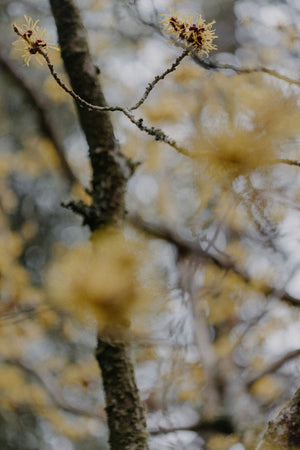
Common Questions
Where should I plant witch hazel? Choose a location with full sun to light shade, well-drained soil, and enough space for its mature spread. Avoid overly dry or compacted sites.
How to plant witch hazel? Dig a hole twice as wide as the root ball, plant at the same depth, and water thoroughly. Apply mulch around the base without touching the trunk.
How to use witch hazel in my yard? Use as a seasonal focal point, part of a mixed border, or in naturalized woodland plantings. Its winter flowers and fall color make it ideal for four-season gardens.
Is witch hazel poisonous to dogs or cats? Witch hazel is not considered toxic to dogs or cats. However, ingestion of large amounts may still cause digestive upset.
Do deer eat witch hazel? Witch hazel is generally deer resistant, though young plants may be browsed in harsh winters.
Do rabbits eat witch hazel? Rabbits may nibble tender stems, especially on young plants, but it is not a preferred food source.
How fast does witch hazel grow? Witch hazel has a moderate growth rate, typically growing 12 to 18 inches per year under ideal conditions.
How big does witch hazel get? Most varieties grow 10–15 feet tall and wide, though some stay smaller or grow taller depending on species and growing conditions.
Does witch hazel need full sun? Full sun is best for abundant flowering and vivid fall color, though partial shade is tolerated.
Conclusion
Witch hazel is a distinctive shrub that adds color, fragrance, and charm to the garden when little else is blooming. With its graceful form, reliable cold-weather display, and low-maintenance care needs, Hamamelis is an ideal choice for winter gardens, native landscapes, and four-season interest. Whether planted as a focal point or blended into a woodland border, witch hazel brings beauty and utility to any setting.

